It doesn't look like a sizzle or a frizzle at all and, yes, it's a boy.
Navigation
Install the app
How to install the app on iOS
Follow along with the video below to see how to install our site as a web app on your home screen.
Note: This feature may not be available in some browsers.
More options
You are using an out of date browser. It may not display this or other websites correctly.
You should upgrade or use an alternative browser.
You should upgrade or use an alternative browser.
Cochin Thread!!!
- Thread starter Settler'sDreamFarm
- Start date
Quote:
Hi Nadine,
Do you mean any buff offspring from your MFC project, or your actual buff hens back to your white roo?
And you know if you wanted all pullets, you'd get cockerels galore!! LOL I'd love to see pics, if you have any.
So would I get buffs and reds and breed them to my black mottled? Those would come out split to mottled and split to red (or buff, whichever the case might be)..then interbreed those and I should end up with some buff mottleds? Or should I breed back to another mottled, but would that cancel out the recessive buff and red? I have a little pullet that I got from an MFC breeder...she's mainly just mottled some light cheverons (super light) and some columbian neck markings, could she help me in breeding for what I want?
Genetics really mess me up. LOL
Thanks, in advance, for any help!

Hi Nadine,
Do you mean any buff offspring from your MFC project, or your actual buff hens back to your white roo?
And you know if you wanted all pullets, you'd get cockerels galore!! LOL I'd love to see pics, if you have any.
So would I get buffs and reds and breed them to my black mottled? Those would come out split to mottled and split to red (or buff, whichever the case might be)..then interbreed those and I should end up with some buff mottleds? Or should I breed back to another mottled, but would that cancel out the recessive buff and red? I have a little pullet that I got from an MFC breeder...she's mainly just mottled some light cheverons (super light) and some columbian neck markings, could she help me in breeding for what I want?
Genetics really mess me up. LOL
Thanks, in advance, for any help!

- Jun 6, 2011
- 142
- 0
- 91
b/c I bought my first two Cochins I wanted to post some pics....they are soooo cute with the fluffy feet!




The older one seems to be best buds with my Barred Rock baby, which is about 5 weeks old, they're the same size just the BRs are less fluffy.


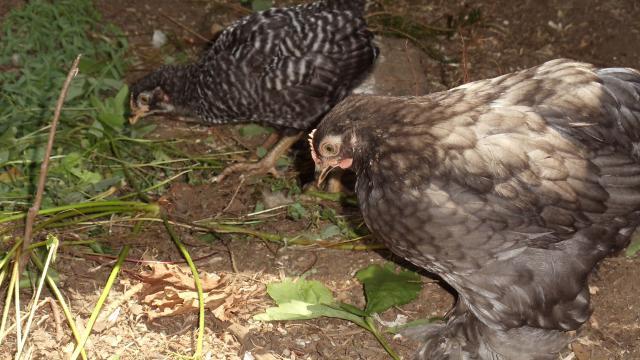
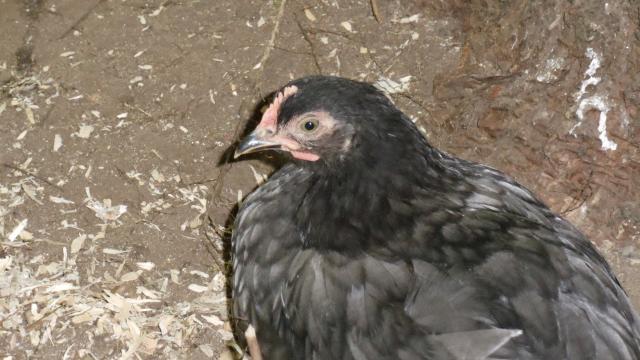
The older one seems to be best buds with my Barred Rock baby, which is about 5 weeks old, they're the same size just the BRs are less fluffy.
Last edited:
Quote:
Hi Nadine,
Do you mean any buff offspring from your MFC project, or your actual buff hens back to your white roo?
And you know if you wanted all pullets, you'd get cockerels galore!! LOL I'd love to see pics, if you have any.
So would I get buffs and reds and breed them to my black mottled? Those would come out split to mottled and split to red (or buff, whichever the case might be)..then interbreed those and I should end up with some buff mottleds? Or should I breed back to another mottled, but would that cancel out the recessive buff and red? I have a little pullet that I got from an MFC breeder...she's mainly just mottled some light cheverons (super light) and some columbian neck markings, could she help me in breeding for what I want?
Genetics really mess me up. LOL
Thanks, in advance, for any help!

Yes, any buff or buff looking mottleds that come from crossing up some MFC or Calicos.
I am getting some very dark mottled even from crossing in my white roo because he is not a dominant white. But I plan to cross his daughters back to him and they carry the Mottled gene....or at least some do. It is just something to work with for a while.
I do not have any recent photos of my girls but need to get some. They are very pretty but I can't seem to copy what they are. I wish I could hit a button and the genetics would come out on a scroll or something. Heck, if it came out in the poop I would still love to see it!

You could certainly try a buff to a black Mottled but it will be a long road for you, too. I don't think red would work this early in the game but if I had it I would certainly add it later. I want some reds so badly but have no where to house them and no more time to care for more birds. I am trying to get under 500 but it isn't working so well. I am still hovering around the 700 mark and I don;t feel I can care for them all as well as I would like to. I just need to clone myself....about 10 times over!

The Columbian neck markings and wing/tail feathers are hard to get rid of but with a Mottled it is a bit easier than with some other varieties.
All I can say is try it. When I study the genetics and then apply it I usually get surprises because there is so much stuff hidden in the birds we don't see. Since so many birds do not have pedigrees you really don't know what the genotype is, you just have to rely on phenotype and keep breeding to determine what yours actually carries.
Hi Nadine,
Do you mean any buff offspring from your MFC project, or your actual buff hens back to your white roo?
And you know if you wanted all pullets, you'd get cockerels galore!! LOL I'd love to see pics, if you have any.
So would I get buffs and reds and breed them to my black mottled? Those would come out split to mottled and split to red (or buff, whichever the case might be)..then interbreed those and I should end up with some buff mottleds? Or should I breed back to another mottled, but would that cancel out the recessive buff and red? I have a little pullet that I got from an MFC breeder...she's mainly just mottled some light cheverons (super light) and some columbian neck markings, could she help me in breeding for what I want?
Genetics really mess me up. LOL
Thanks, in advance, for any help!

Yes, any buff or buff looking mottleds that come from crossing up some MFC or Calicos.
I am getting some very dark mottled even from crossing in my white roo because he is not a dominant white. But I plan to cross his daughters back to him and they carry the Mottled gene....or at least some do. It is just something to work with for a while.
I do not have any recent photos of my girls but need to get some. They are very pretty but I can't seem to copy what they are. I wish I could hit a button and the genetics would come out on a scroll or something. Heck, if it came out in the poop I would still love to see it!

You could certainly try a buff to a black Mottled but it will be a long road for you, too. I don't think red would work this early in the game but if I had it I would certainly add it later. I want some reds so badly but have no where to house them and no more time to care for more birds. I am trying to get under 500 but it isn't working so well. I am still hovering around the 700 mark and I don;t feel I can care for them all as well as I would like to. I just need to clone myself....about 10 times over!

The Columbian neck markings and wing/tail feathers are hard to get rid of but with a Mottled it is a bit easier than with some other varieties.
All I can say is try it. When I study the genetics and then apply it I usually get surprises because there is so much stuff hidden in the birds we don't see. Since so many birds do not have pedigrees you really don't know what the genotype is, you just have to rely on phenotype and keep breeding to determine what yours actually carries.
Just have to post a cute picture, this little buff pullet I call Shirly Temple because of her fluffy pantiloons, she even co-operated and got on the boards to do a tap dance. lol !


I have a buff mottled girl with a kind of light wheaten mark on each feather. She was from an undermarked mfc to a bc/black mottled cross


Last edited:
This is one of my better marked girls I have going. I posted a photo of her back in the winter on this thread, too, when she was but a wee chick. She needs better type but she has given me a lot of the pattern I want and the color is coming through okay.


Here is one that needs a bit of work. I have a ways to go with her and her sisters so I am looking for just the right guy.

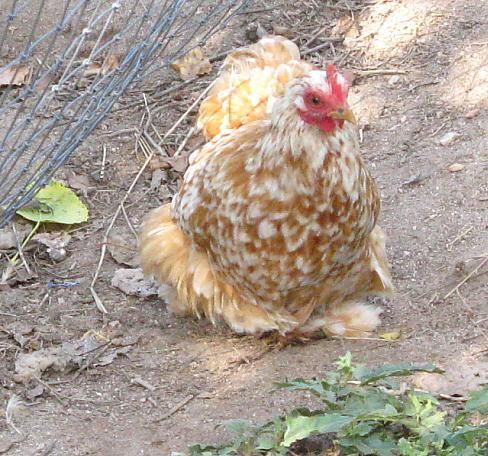
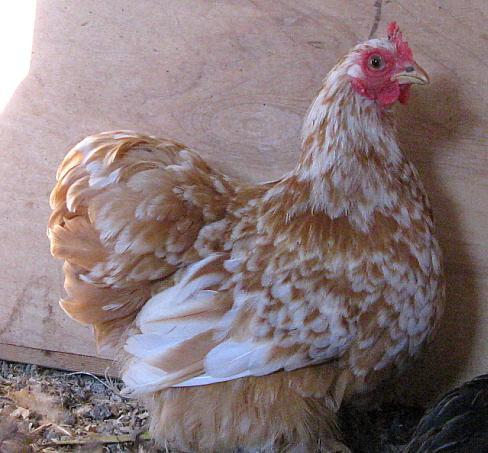
Here is one that needs a bit of work. I have a ways to go with her and her sisters so I am looking for just the right guy.
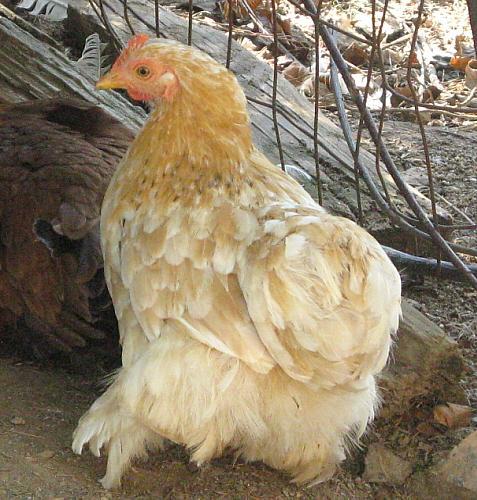
Here is another of the buff Mottled project.
Unfortunately, she has been broody for about 2 months and isn't laying. I take eggs away but as soon as someone lays another she is in the coop and on the nest shoving the poor layer out of the nest! She's a riot. Then if another sees her in there she will join her so by evening feeding I am throwing them all back outside again.

Unfortunately, she has been broody for about 2 months and isn't laying. I take eggs away but as soon as someone lays another she is in the coop and on the nest shoving the poor layer out of the nest! She's a riot. Then if another sees her in there she will join her so by evening feeding I am throwing them all back outside again.
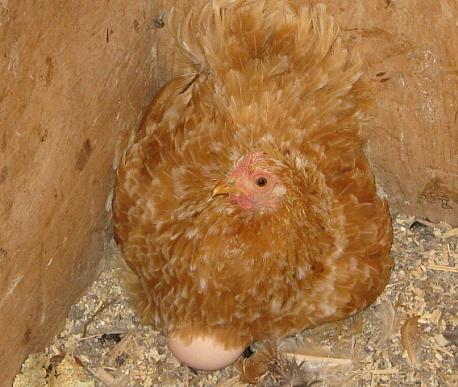
Quote:
I thought I was getting straight cochin, but I got this one to hatch with the others...the person that sent them said that it is a sizzle, just straight feathered sizzle. I sent her the same pictures to check out, because I wondered about the funny top on him. him..

I thought I was getting straight cochin, but I got this one to hatch with the others...the person that sent them said that it is a sizzle, just straight feathered sizzle. I sent her the same pictures to check out, because I wondered about the funny top on him. him..

New posts New threads Active threads
-
Latest threads
-
-
How to keep my chickens' combs from freezing
- Started by Chickenbubble22
- Replies: 0
-
-
-
Article embed feature not working?
- Started by StinkyAcres
- Replies: 0
-
-
Threads with more replies in the last 15 days
-
-
-
I culled my first cockerel, now what?
- Started by redinator
- Replies: 101
-
-
*Answer These Questions The Best You Can Please *
- Started by N3mesis_IceWing_NightWing
- Replies: 63
-
×
